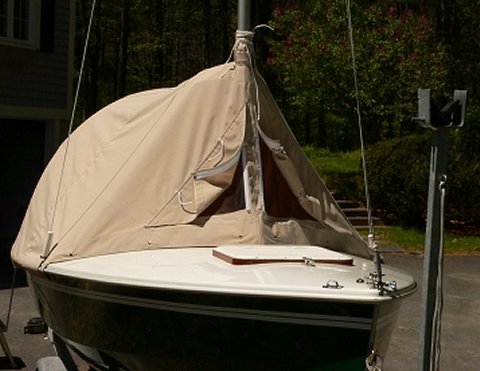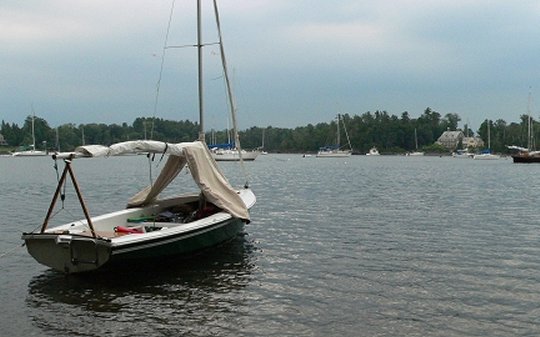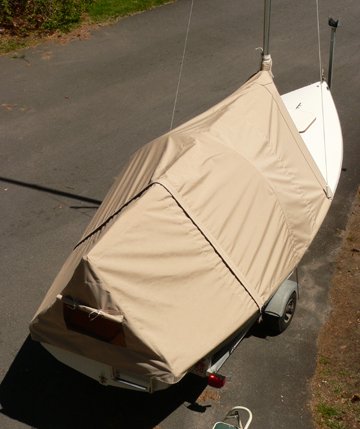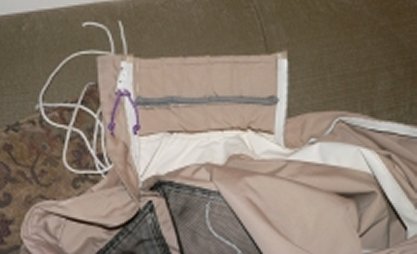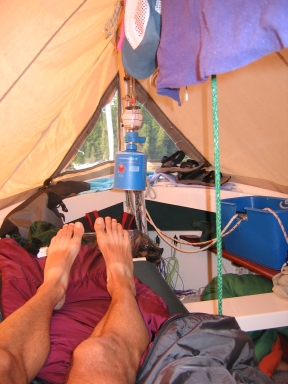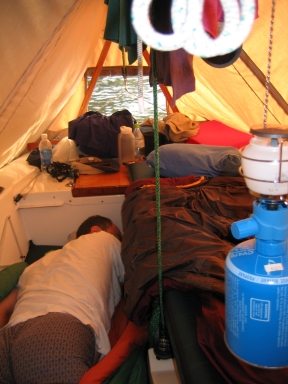Subject: Tom Graefe's boom tent
(response to the Barry Antel inquiry)
|
| response from Barry Antel with Dick H notes added in
red On Thu, 15 Sep 2005 18:39:20 -0400 Barry Antel <kbsailing@mac.com> writes: Hi Tom, Thanks for the great write-up on your boom tent. I have a few comments and further questions. 1. The continuous reinforcement with "Top Gun" fabric sounds like an ideal solution to the Sunbrella strength issue. (Dick: On my tent Hans sewed a wear liner - about 6" wide and kind of a slippery nylon type of material - along the ridge where the boom contacts.) I have, on a previous boat, had fasteners prevented from from pulling out using leather sewn to the Sunbrella at fastener points. It looks like I will probably be going with dome fasteners for attachment to the hull. The only other fasteners that I really like are the bronze ones that push through an oval-shaped receptacle in the canvas, and then turn 90 degrees. Those are very strong and last virtually forever, but the fittings that attach to the boat are too high in profile for this application (and also a bit pricey). 2. Is there any advantage to mounting the dome fasteners to the underside of the rubrail? I currently have some on the hull for my flat cover that are mounted a few inches below the rubrail (in the cove stripe). If there is an advantage beyond avoiding the holes in the hull (too late for me on that one) I will certainly consider filling the underside of the rubrail. (Dick: Everything I've seen has been attached below the rub rail. It was a mistake to go through the hull, plus there's the chance of hitting on docks and other things that can rub against the hull.) 3. The single pole that fits into the oarlocks does look like it adds a lot of volume to the interior at, like you said, a minimum penalty in setup time. However, since I am still leaning toward ordering a cover from Hans Gottschling, (using his existing basic pattern as a starting point to keep the cost down), I think that I may not be able to incorporate a similar idea for this version of my boom tent. Speaking of price, how much did your custom cover end up costing from the canvas maker (if you don't mind me asking)? 4. The water intrusion from the mast will probably never be solved on my boat because I can have a perfect seal between the cover and the outside of the spar but the water will still run down the inside due to the openings for internal halyards, holes for the stays, and the sail groove. This is where boats that have the mast stepped on the cabin or foredeck top have an advantage- all that water just drains outside. The tabernacle is one of the reasons I bought a Wayfarer, though. 5. The limited availability of stowage space on the Mark III boats is the reason that I have eliminated my plans for adding vinyl panels to the windows. Although it would be nice to look out while it is raining stowing the cover would become more difficult due to having to avoid creasing the windows. (Dick: Only once on this year's Chesapeake cruise did I need to close the foreward windows, the aft window never needs to be closed, even in the worst weather. Even in cool weather you want the windows to be open if at all possible. Hans was too stingy with the Velcro on my window seals, ask for more Velcro.) 6. My current abstract plan for the forward windows is to have the covers have a large overlap beyond the screen for watertightness, and enough velcro and snap fasteners to keep them properly closed if I want to. 7 and 8. All ideas applicable specifically to the Abbott Mark III boats are of great interest to me. These boats require new solutions to some problems that the other iterations of the Wayfarer don't have to deal with. Tying the oars to the boom still leaves them much more accessible than incorporating them into the boom tent, as I have seen on some designs. (Dick: Before I eliminated the aft benches and was in the habit of moving them forward each night I used to tie the oars to the foredeck. Lay the oars outside the tent with the blades inside the shrouds, cross the handles inside the forestay and wrap a bungy around them. They'll stay there happily through hell and high water.) The dry floor issue, as you mentioned, doesn't appear to be any worse for the Mark III's compared to other Wayfarers (unless, of course, they keep their floorboards somewhere dry until ready to bed down for the night!). We unfortunately just don't have anywhere for that dribble of water to go after it comes down the mast when it is pouring rain. Raising the sleeping surface (with your cot) sure seems to get around that problem quite nicely. Thanks again, Barry (W7671) This email was cleaned by emailStripper, available for free from http://www.papercut.biz/emailStripper.htm |
| thanks from Barry... -----
Original Message -----
From:
Barry
Antel
Cc:
TM
Graefe ; uncle-al@cogeco.ca
Sent:
Friday, September 16, 2005 1:59 PM
Subject:
Boom tent
I am discovering the benefits of having some very helpful fellow owners to be one of the high points of owning a Wayfarer. Thanks. I'm looking forward to meeting you in person... Best, Barry |
